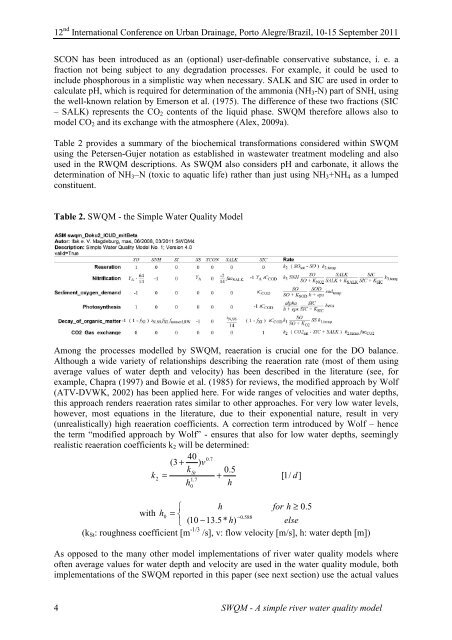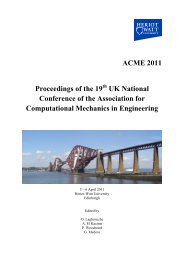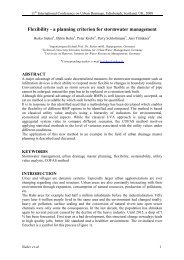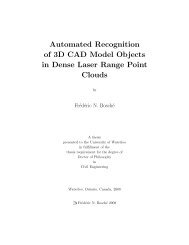SWQM - A simple river water quality model for assessment of urban ...
SWQM - A simple river water quality model for assessment of urban ...
SWQM - A simple river water quality model for assessment of urban ...
You also want an ePaper? Increase the reach of your titles
YUMPU automatically turns print PDFs into web optimized ePapers that Google loves.
12 nd International Conference on Urban Drainage, Porto Alegre/Brazil, 10-15 September 2011<br />
SCON has been introduced as an (optional) user-definable conservative substance, i. e. a<br />
fraction not being subject to any degradation processes. For example, it could be used to<br />
include phosphorous in a simplistic way when necessary. SALK and SIC are used in order to<br />
calculate pH, which is required <strong>for</strong> determination <strong>of</strong> the ammonia (NH3-N) part <strong>of</strong> SNH, using<br />
the well-known relation by Emerson et al. (1975). The difference <strong>of</strong> these two fractions (SIC<br />
– SALK) represents the CO2 contents <strong>of</strong> the liquid phase. <strong>SWQM</strong> there<strong>for</strong>e allows also to<br />
<strong>model</strong> CO2 and its exchange with the atmosphere (Alex, 2009a).<br />
Table 2 provides a summary <strong>of</strong> the biochemical trans<strong>for</strong>mations considered within <strong>SWQM</strong><br />
using the Petersen-Gujer notation as established in waste<strong>water</strong> treatment <strong>model</strong>ing and also<br />
used in the RWQM descriptions. As <strong>SWQM</strong> also considers pH and carbonate, it allows the<br />
determination <strong>of</strong> NH3–N (toxic to aquatic life) rather than just using NH3+NH4 as a lumped<br />
constituent.<br />
Table 2. <strong>SWQM</strong> - the Simple Water Quality Model<br />
Among the processes <strong>model</strong>led by <strong>SWQM</strong>, reaeration is crucial one <strong>for</strong> the DO balance.<br />
Although a wide variety <strong>of</strong> relationships describing the reaeration rate (most <strong>of</strong> them using<br />
average values <strong>of</strong> <strong>water</strong> depth and velocity) has been described in the literature (see, <strong>for</strong><br />
example, Chapra (1997) and Bowie et al. (1985) <strong>for</strong> reviews, the modified approach by Wolf<br />
(ATV-DVWK, 2002) has been applied here. For wide ranges <strong>of</strong> velocities and <strong>water</strong> depths,<br />
this approach renders reaeration rates similar to other approaches. For very low <strong>water</strong> levels,<br />
however, most equations in the literature, due to their exponential nature, result in very<br />
(unrealistically) high reaeration coefficients. A correction term introduced by Wolf – hence<br />
the term “modified approach by Wolf” - ensures that also <strong>for</strong> low <strong>water</strong> depths, seemingly<br />
realistic reaeration coefficients k2 will be determined:<br />
k<br />
2<br />
40 0<br />
( 3 + ) v<br />
k<br />
=<br />
h<br />
St<br />
1.<br />
7<br />
0<br />
. 7<br />
0.<br />
5<br />
+<br />
h<br />
⎧<br />
with h0<br />
= ⎨<br />
⎩<br />
h<br />
− 0.<br />
588<br />
( 10 −13.<br />
5*<br />
h)<br />
<strong>for</strong> h ≥ 0.<br />
5<br />
else<br />
(kSt: roughness coefficient [m -1/3 /s], v: flow velocity [m/s], h: <strong>water</strong> depth [m])<br />
As opposed to the many other <strong>model</strong> implementations <strong>of</strong> <strong>river</strong> <strong>water</strong> <strong>quality</strong> <strong>model</strong>s where<br />
<strong>of</strong>ten average values <strong>for</strong> <strong>water</strong> depth and velocity are used in the <strong>water</strong> <strong>quality</strong> module, both<br />
implementations <strong>of</strong> the <strong>SWQM</strong> reported in this paper (see next section) use the actual values<br />
4 <strong>SWQM</strong> - A <strong>simple</strong> <strong>river</strong> <strong>water</strong> <strong>quality</strong> <strong>model</strong><br />
[ 1/<br />
d]













